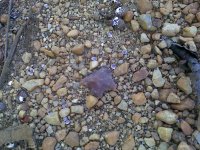Every country boy from the time of the pilgrims until now knows that arrowheads are made of flint. Then you also have the Flint River near Savannah, GA which is full of flint. And you have Flintridge in Ohio. It’s a 9 mi. long ridge, full of flint. What about the Flint Hills of Kansas? Flint laying everywhere. Aren’t all of the above sources of flint?
Well, no, not really. Geologists tell us that flint has very specific properties. Without even one of these, it’s not flint by definition. To be flint, said rock needs to be Cretaceous in age, it has to have formed in chalk beds, it has to have a very high silica content in the upper 90% range, it has to be nodular as opposed to layered or bedded, it has to be black or brown in color and a thin flake has to be translucent.
This description exactly fits the deposits in So. England and Denmark. Also near Haifa Israel. But what about the U.S., do we have any true flint? Yes, but not much. Only two places in the U.S. fill the bill for true flint. These are the White River of SD and Georgetown, TX. So if you picked up an arrowhead from one of those two places, you might have a flint arrowhead. If not, you don’t.
If it’s not flint, what is it? There are many materials that are cryptocrystalline quartz that breaks with a conchoidal fracture. Chert, chalcedony, agate, obsidian, petrified wood, agatized coral, rhyolite, quartz crystal, slate, and probably a few more I can’t think of. So should we stop using the word flint? Absolutely not. It’s a traditional word that really covers all of the “other” arrowhead rocks. When they change the name of the Flint River in GA to “Chert River”, then I’ll think about calling it "chert". The geologists and archaeologists will always use the word “chert” but only us country boys (and April Taylor) get to use “flint”. HaHa!
Interestingly, there is one other place in the U.S. to obtain true English flint. When the U.S. was a British colony ships came “empty” and went back loaded with heavy timber. A ship can’t sail “empty” so they had to add ballast in England before they left. Flint was free and everywhere on the south east coast. They loaded tons of it, sailed to New York and went up the Hudson River and dumped the flint before loading their cargo. One wonders how many times that happened and where did they dump it? I know a guy that recovered some but is tight lipped about the location. Quality flint nodules that have been tested as good go for $3/lb. at the flint knap-ins and rendezvous for gun flint users. A few dollars could be made if you could locate one of those cargo hold dumps in the Hudson. Any treasure hunters in the house? Gary
Well, no, not really. Geologists tell us that flint has very specific properties. Without even one of these, it’s not flint by definition. To be flint, said rock needs to be Cretaceous in age, it has to have formed in chalk beds, it has to have a very high silica content in the upper 90% range, it has to be nodular as opposed to layered or bedded, it has to be black or brown in color and a thin flake has to be translucent.
This description exactly fits the deposits in So. England and Denmark. Also near Haifa Israel. But what about the U.S., do we have any true flint? Yes, but not much. Only two places in the U.S. fill the bill for true flint. These are the White River of SD and Georgetown, TX. So if you picked up an arrowhead from one of those two places, you might have a flint arrowhead. If not, you don’t.
If it’s not flint, what is it? There are many materials that are cryptocrystalline quartz that breaks with a conchoidal fracture. Chert, chalcedony, agate, obsidian, petrified wood, agatized coral, rhyolite, quartz crystal, slate, and probably a few more I can’t think of. So should we stop using the word flint? Absolutely not. It’s a traditional word that really covers all of the “other” arrowhead rocks. When they change the name of the Flint River in GA to “Chert River”, then I’ll think about calling it "chert". The geologists and archaeologists will always use the word “chert” but only us country boys (and April Taylor) get to use “flint”. HaHa!
Interestingly, there is one other place in the U.S. to obtain true English flint. When the U.S. was a British colony ships came “empty” and went back loaded with heavy timber. A ship can’t sail “empty” so they had to add ballast in England before they left. Flint was free and everywhere on the south east coast. They loaded tons of it, sailed to New York and went up the Hudson River and dumped the flint before loading their cargo. One wonders how many times that happened and where did they dump it? I know a guy that recovered some but is tight lipped about the location. Quality flint nodules that have been tested as good go for $3/lb. at the flint knap-ins and rendezvous for gun flint users. A few dollars could be made if you could locate one of those cargo hold dumps in the Hudson. Any treasure hunters in the house? Gary
Amazon Forum Fav 👍
Last edited:
Upvote
0








